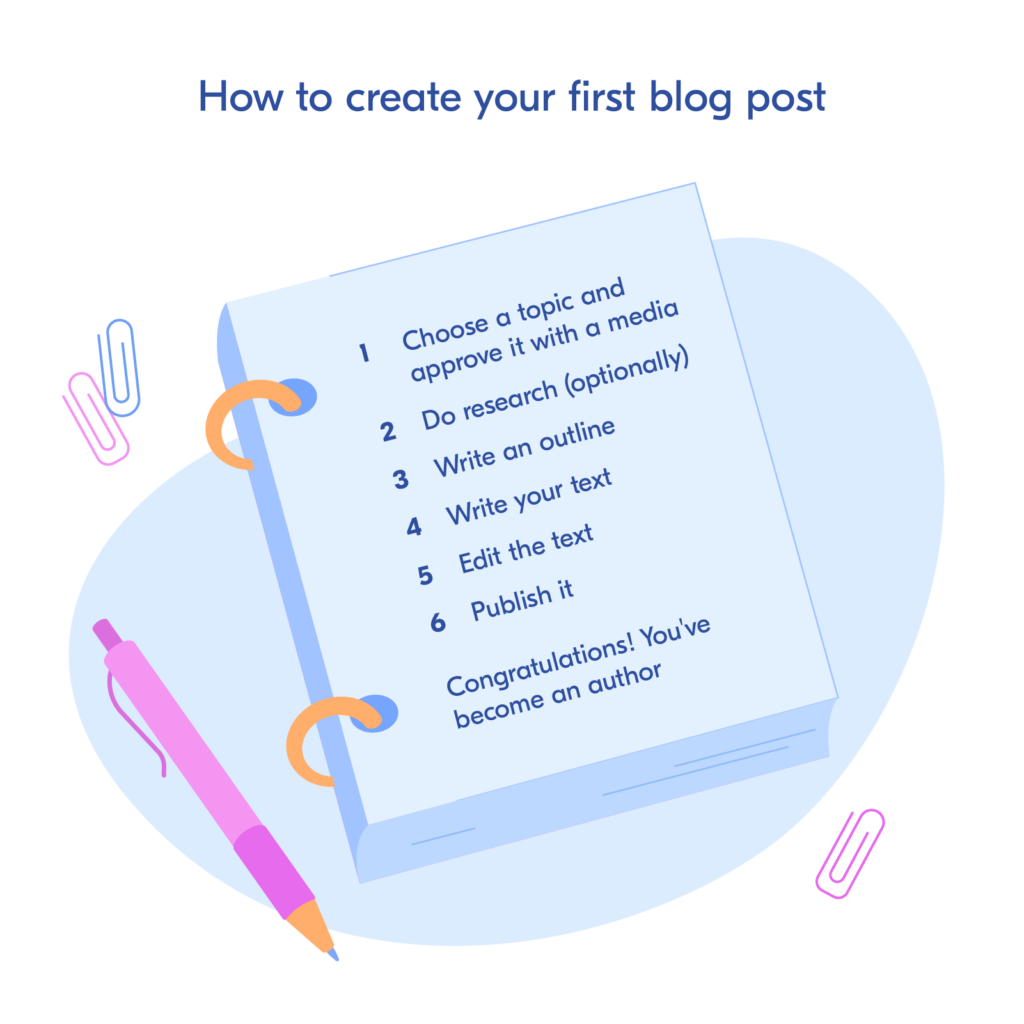
Should specialists write their blog posts, and why?
The answer is – definitely yes! A technical copy written by a specialist is more valuable than a post created by a content writer. The hands-on experience you have as a specialist allows you to craft an expert-level, insightful copy that others can use to self-learn.
At Railsware, we have many tech specialists who write great copies for our blog and external media. I’ve spoken with them to find out what motivates each of them.
I like to express my thoughts on paper. I even worked in a newspaper in the past. But the reason I started writing articles after becoming a recruiter is the desire to share my observations and get feedback. I want to understand whether my vision of the situation coincides with the opinions of other people, especially those whom I want to recruit 😉. Our world is changing very quickly, and I want to operate with modern and relevant approaches in my work.

Daryna Kuzmyk
Recruitment Expert

Dmitriy Shcherbakan
Software Engineer
I mostly write tutorials to share my experience and knowledge and help others master this or that material faster. Sometimes I choose a topic about which I know almost nothing as an incentive to learn something new. When there is a topic, a deadline, and an agreement with some media about the material – you have to do it, whether you want it or not.
In addition to some practical topics, I often choose to write about things that bug me the most. For me, it’s like therapy — an excellent way to vent and help others avoid certain mistakes.

Julia Ryzhkova
Product manager

Leonid Shevtsov
Software Engineer
Writing has always been difficult for me. But there are two reasons why I write regularly and even started my own blog. First, it’s a simple desire not to forget things I have worked on. If today I figured out how to use a particular pattern or tool in a year, I won’t remember how I did it. And if I make notes on how I did this or that, then after a while, I can easily repeat the process faster. Second, if I work a bit on those notes and transform them into a post, I can share it and help others save their time too.
Leonid also said it would be great if all specialists wrote and shared relevant knowledge about their professions and domains. Even without perfect illustrations and with some stylistic mistakes, such posts would speed up knowledge sharing, education, and industry progress. And I fully support this idea.
How to write a post step by step
Every large task seems complex until it’s decomposed. Follow our simple step-by-step guide to write your first post and share it with the world.

Step 1. Choose a topic and approve it with a media
How to choose a topic for your post? Think about the knowledge you can share with others. It can be something you learned recently or something that is the basis for your profession.
All the time, I make notes about interesting problems and little things that surprise me. Periodically I go through the notes and select a certain topic, which will make a foundation for my next post.

Julia Romanenkova
Product manager
At this stage, you should shape a portrait of the reader, meaning the person for whom you are writing the material. If this is a beginner, don’t use complex terminology in the text. If it is a person of approximately your level, you can incorporate more difficult concepts.
When you understand who the readers would be, think or google how this audience searches for information and what it reads. Contact the media and offer them your material. Do that before writing the text because the editor may ask you to change the topic slightly.
There is another option for publishing articles, which Leonid Shevtsov chose for himself. After one of his early articles disappeared (later, it turned out that the media had changed the URL of the post), he decided to start his own blog to publish all the materials. This option is suitable for those who choose to write regularly and want to build their brand.
Step 2. Do the research (optional)
Research may not be necessary if the post is about your personal experience, thoughts, and ideas. As a foundation for the posts, my colleagues often use the notes they do whenever they face something interesting.
However, some people always check published articles before writing their material.

Dmitriy Shcherbakan
Software Engineer
I often write tutorials, but I always check what is already published on the topic. I want my posts to be useful, so I look for a new, better way to demonstrate the capabilities of a technology or tool. I’ll write a post with more complex or simple examples and new use cases.
Step 3. Write an outline
An outline is one of the most critical steps in creating a large piece of text content. It helps to make the article coherent, not lose important details, and not deviate from the main topic.
I create outlines for every post. This way, I see the scope of the work, stay within the chosen topic, and maintain a logical flow of thoughts in the text.

Dmitriy Shcherbakan
Software Engineer
Some would form an outline in their head, but I advise you to write everything down. If you do so, you can see what’s missing and immediately add your ideas for code examples, illustrations, or videos in case you plan to have such content in your post. You can also plan where to create images that will support your key ideas and make the content more engaging or easier to understand. If you want to explain a process or concept more visually, consider using an AI animation video generator to produce short, informative clips.
Step 4. Write the text
Use your outline as a roadmap when writing the text. If you don’t know how to start your post, imagine that a friend or relative has asked you to explain the topic.

Julia Ryzhkova
Product manager
If you’re sharing your personal ideas and experience, it is a good idea to introduce yourself and tell a little about your background at the beginning of the post. You should explain why you write on this topic to create trust in your material.
Don’t re-read and edit each finished sentence when working on the text. Save editing for later. Write down your thoughts as they appear in your head.
Step 5. Edit the text
Re-read the text and look at it as a whole. What’s missing? Maybe you forgot to add an example or explain a new term. Add the text that will fill in the gaps in the material.
Now, it’s time to get rid of everything non-essential. Maybe some paragraphs are irrelevant to the topic and only bloat the material? Delete them.
Read each paragraph separately and select sentences that do not contain new information. Sometimes, when editing a text, I highlight a sentence in red and read a section without it. If the idea is still evident, I remove the sentence.
When to stop editing? Only you can answer this question, probably when you like the result. Nevertheless, I advise you not to re-read the same thing 200 times. It will only confuse you.
Get back to the visual components of your article. Make sure you have everything ready.
Step 6. Publish your post
Contact the media and hand over your material. Ask when they will publish it. On the set date and time, uncork the champagne and call all your relatives to brag (optional).
Dos and Don’ts when writing a post
Talking to product managers, developers, recruiters, and other specialists who craft articles regularly, I asked them to share tips for those who want to start writing. Here is what they advise from their own experience.
Dos
- Collaborate with professional content writers if writing is still difficult for you. This format of authorship is quite common and often beneficial to the company you work for. – Yulia Ryzhkova
- If you want to start writing, you can begin with a short TIL (today, I learned) notes. This is a great way to practice and get used to the activity. As a bonus, you will receive many ideas for future posts. – Dmytro Shcherbakan
- If you decide to write an article, set yourself a clear deadline. Otherwise, it will remain an idea. – Leonid Shevtsov
- Give people the answers they came for. If your article aims to answer some question or solve a problem, highlight the text with your solutions and recommendations. – Julia Romanenkova
- If a media editor asks you to shorten an article, prioritize the blocks and eliminate those that are less useful for a reader (even if it’s painful). – Julia Romanenkova
- Save yourself time and check your text uniqueness and grammatical errors with some online tools. – Dmytro Shcherbakan
- If you feel it is difficult to edit your draft right away, leave it for a while (1-2 days). – Daryna Kuzmuk
- When working on a tutorial, find a convenient tool to work with code and text in one place. – Dmytro Shcherbakan
- Add a bookmark to each section of the article. This way, you can share links to separate sections of the material. – Dmytro Shcherbakan
Don’ts
- Don’t choose a “hype topic” if you have nothing to say. It is better to take a topic you understand well and can share something useful on. – Yulia Ryzhkova
- When working on a tutorial, don’t explain everything in code, and don’t make the code snippets too big. Don’t describe everything that doesn’t relate to your topic. Let the tutorial be short and clear. – Dmytro Shcherbakan
- Don’t add code examples in the form of illustrations. Your readers likely want to copy the code, so don’t make life difficult for them. – Dmytro Shcherbakan
Parting thoughts
Imagine seeing a post explaining how to solve a problem you have spent days trying to tackle. How cool would it be to get the solution earlier? Now think about all the people struggling to find answers you already know. So why not share them? Writing articles is one of the simplest and fastest ways to exchange knowledge and help others learn, find necessary solutions, grow, and improve faster.